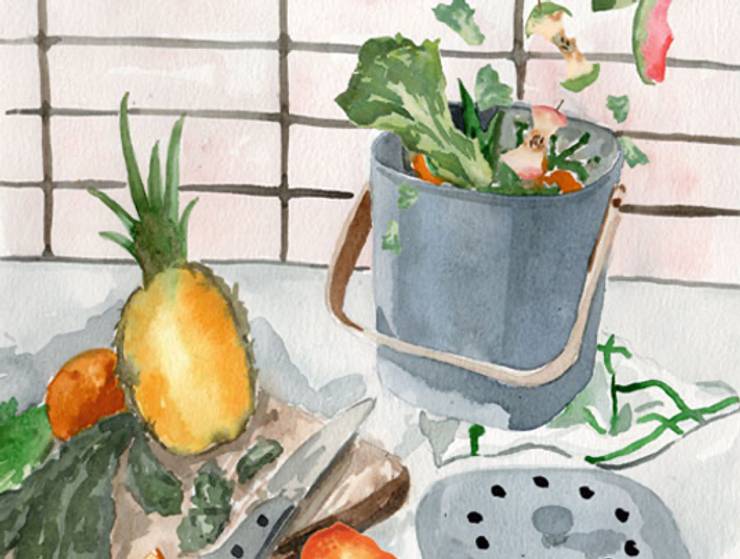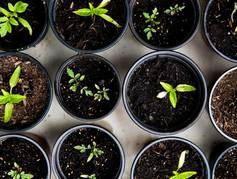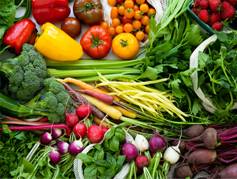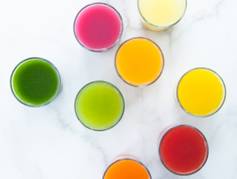Articles
5 Simple Steps That Will Reduce Your Food Waste
If you’ve ever thrown lemon rinds and apple cores in the trash before or tossed whole produce because they went bad before you had a chance to enjoy them, you’re not alone. We’ve been there, too. But what if we told you those rinds and apple cores are more powerful than you think? So powerful that treating these scraps differently could help you take an important climate action right in your own kitchen.
When we toss food into the trash, we’re contributing to a major food waste issue—one that accounts for 4.4 gigatons of greenhouse gas emissions annually.1
How Food Waste Works
When you throw away produce scraps, those food leftovers go to landfills and break down to produce methane gas. When food is wasted in this way, it not only contributes to climate change, but it also wastes all the other factors such as water, packaging, labor and transportation required to process and deliver your food.
Fresh vegetables and fruit are the most frequently disposed of food, and households are one of the largest producers of food waste.
Data from the U.K. shows residential homes create up to 7 million tons of wasted food per year.2 While in the U.S., just one person can generate up to 219 pounds of wasted food in a year.3
Landfills are the third-largest source of human-related methane emissions in the United States alone, according to the U.S. EPA.4 If these numbers are shocking to you, there are things you can start doing today to make a difference.
1. TAKE STOCK AND ORGANIZE YOUR FRIDGE
A big part of the food waste problem starts in the fridge, according to a 2019 study published in the journal Resources, Conservation and Recycling.5 The refrigerator is a great invention,” said Brian Roe, professor at The Ohio State University and senior author of the study, in an interview with Earth Day Network. “It helps you store food and extend its shelf life and should help us prevent food waste, but yet we have really no idea what the average American does with their refrigerator.”
Researchers in this study discovered a huge gap between what consumers planned to eat and what they actually finished. For fruits and vegetables, people ate just 40 percent of what was in their fridge before it went bad. A 2018 U.S. Department of Agriculture study found that American consumers waste about one pound of food every day.6
One way to help reduce food waste is to keep an inventory of what’s in your fridge. Start your audit by pulling all fresh produce out of your fridge, wiping it down and checking the freshness of each item. Sort the produce that needs to be eaten quickly from the items that have more time.
Always put the foods that need to be eaten first front and center, so you don’t forget about them. Try not to overstock your shelves or produce drawers and be sure to store leftovers in clear containers to easily see the contents.
Don’t forget to check expiration dates on items that have been shoved to the back and smell them before you toss them. Fun fact: the date on food is usually a sell-by date of when it is most fresh, but it doesn’t need to be thrown away on that date.
2. PLAN YOUR MEALS
You’ve probably heard this before but try to plan your meals before you shop. Need some inspiration? Check out some of our delicious juice recipes here.
Take time before your next trip to the farmers’ market or grocery store to pre-plan and stick to your list as much as you can. When you have a plan for your food, you are much less likely to let anything go to waste.
Also, if you see a new-to-you veggie or fruit at the market and want to try it, don’t be afraid to talk to the farmer or grocery store employee to see if they have a recipe for it. People who work in the food industry love food and can act as a great resource for how to use it. If you want to buy in bulk or take advantage of a sale, make a plan for how you will use that food—cook it, juice it, freeze it or pickle it.
One study also found that making a list can help you choose more nutritious items while shopping.7
If you’re not accustomed to making a list or want to try a new approach, check out a free app for your phone like Out Of Milk, which allows users to create an interactive shopping list and keep an updated pantry inventory. You can also check out Our Groceries, which offers a simple way to keep your grocery list instantly synchronized on all the smartphones in your household.
For those that want even more support with meal planning, check out another free app called Mealime, which helps you create healthy and personalized weekly meal plans, find recipes based on that meal plan, and organize grocery lists around those recipes.
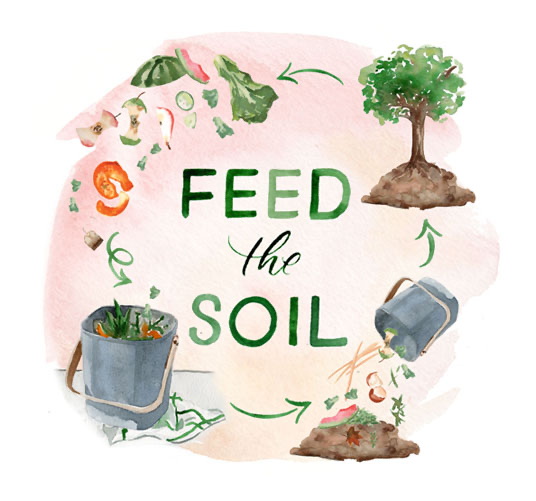 artwork by thescribblist.com
artwork by thescribblist.com
3. COMPOST, COMPOST, COMPOST
You can start by composting your food where it will breakdown into a natural fertilizer and help enrich new crops. It’s wild with everything going on in the world that we haven’t developed a way to divert all food scraps to compost bins, but you can start now by taking action at home.
Composting inedible fruit and vegetable food waste creates a product that can be used to help enhance soil, grow more crops and even improve water quality.8
You can make a difference in your home by diverting your leftover, including all that juice pulp, away from landfills to help grow more plants.
Want to learn more about composting? This article explains exactly how to repurpose your juice pulp and other veggie food scraps.
If DIY isn’t really your thing, try this free directory of composting facilities throughout North America, created and managed by BioCycle magazine that will do it for you: Find a Composter. Or look for a compost pick-up or drop-off service in your area that will collect your compost at an affordable rate.
4. MAKE MORE JUICE
A great way to use up produce is to make a juice—or a smoothie, dressing or sauce. If you’re noticing fruit and veggies starting to wilt, turn them into something delicious that day.
If you had planned to use a red pepper and a cucumber for a dish later in the week, but they’re starting to lose their luster, just juice them.
Another idea is to up the veggies in your dressings. Many people think of salad dressings as something simple like lemon juice, oil and vinegar, but you can pump up any dressing by adding a veggie, fruit or herb that needs to be consumed sooner.
Don’t forget you can also repurpose a tired carrot or celery stalk to make a broth. If you have veggie scraps, simply toss them in a bag or container and keep them in the freezer. Once your bag is full, toss everything into a large pot, add some spices or sea veggies and cover the mixture with water. Let those leftovers simmer for an hour or two and then strain it for a homemade vegetable broth.
Herbs are another food that can easily go to waste. You might buy a bunch of parsley or cilantro for a recipe only to have most of it get lost in the back of the fridge. Don’t forget that herbs can bring a lot of flavors (and added nutrients) to a juice. Stems also work great in a juice, can spice up a homemade dressing or help bring extra flavor to a broth.
And if you’re having trouble finishing the juices that you’ve made, don’t forget to call a friend or neighbor and share the juice love. A fresh juice is a great surprise gift for a birthday, a hard workday or for anyone who is curious about consuming more plants.
5. UTILIZE JUICE PULP AND PEELS
For avid juicers, it can be easy to get in the habit of throwing away juice pulp. Again, compost is a great option but it’s not your only one.
Did you know it can be healthy to eat some of the pulp from your juice? Remember the leftover pulp is the fibrous part of the produce and you can mix a small scoop of it back in for a thicker drink with an added nutritional boost. Or if there’s already a little pulp in your juice, there’s no need to skim it out.
You can also save juice pulp to add to a dip, a dressing or even a smoothie. A tablespoon or two of veggie juice pulp can easily combine with a cream cheese (dairy or non-dairy) to create a colorful spread for crackers or veggies.
Juice pulp is a great base to make a raw veggie cracker, like in these green pulp crackers or homemade veggie burgers. If you have dogs, consider adding some juice pulp to their food to give them some extra fiber. Look at this list of foods to avoid feeding your pets to make sure your pulp is safe for your furry friends.
Leftover fruit pulp can also be saved in ice cube trays with a little bit of water. Add these ice cubes to smoothies or sorbet to get an extra thick texture.
If you juice a lot of citrus fruit and have leftover peels from your lemons, oranges or limes, consider using them for a homemade cleaner. Add your peels to a 16-ounce jar and then fill the jar with equal parts water and white vinegar. After about a week, you will have a homemade cleaning spray for your counters that is naturally scented with your citrus peels.
You can also save lemon or orange peels by drying them out on a counter or use a food dehydrator or your oven on a very low setting at 200 degrees Fahrenheit for 3 hours. Once they are thoroughly dry, you can pulse them in a food processor or blender to make your own vitamin C powder that you can add to smoothies or juices.
The Takeaway
In general, the key to creating less food waste is to become more aware, educate yourself and then implement a plan for change. You can save food scraps from the landfill and reduce methane gas in the environment by composting and changing your habits. At first, it might feel like a few extra steps, but after a week or a month, you will notice that it will get easier and become part of your routine. You don’t have to be perfect and know that each step you take can make an impact for your health and the health of the planet.
sources:
- https://earth.org/the-biggest-environmental-problems-of-our-lifetime
- https://wrap.org.uk/resources/report/food-surplus-and-waste-uk-key-facts
- https://www.epa.gov/sustainable-management-food/united-states-2030-food-loss-and-waste-reduction-goal
- https://www.epa.gov/lmop/basic-information-about-landfill-gas
- https://www.sciencedirect.com/science/article/abs/pii/S0921344919303350
- https://journals.plos.org/plosone/article?id=10.1371/journal.pone.0195405
- https://www.ncbi.nlm.nih.gov/pmc/articles/PMC4430323/
- https://www.epa.gov/sustainable-management-food/reducing-impact-wasted-food-feeding-soil-and-composting
- Choosing a selection results in a full page refresh.
- Press the space key then arrow keys to make a selection.
